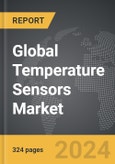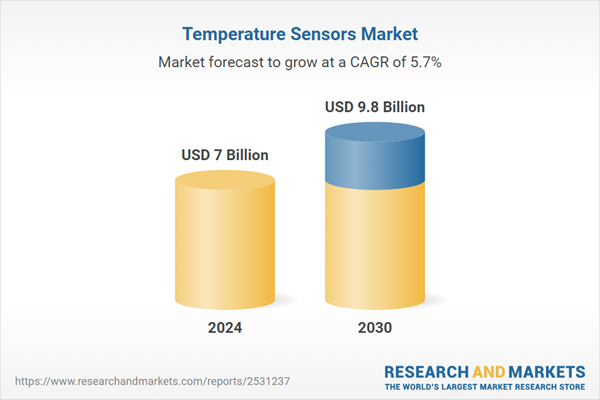The global market for Temperature Sensors was valued at US$7.0 Billion in 2024 and is projected to reach US$9.8 Billion by 2030, growing at a CAGR of 5.7% from 2024 to 2030. This comprehensive report provides an in-depth analysis of market trends, drivers, and forecasts, helping you make informed business decisions. The report includes the most recent global tariff developments and how they impact the Temperature Sensors market.
The technology behind temperature sensors is evolving, incorporating advanced methods such as thermal imaging and infrared pyrometry, which broaden their application and enhance their functionality. Thermal imaging cameras are increasingly utilized in residential settings for home inspections to detect heat leaks and insulation flaws, promoting energy conservation. Infrared pyrometers, which provide precise temperature measurements without direct contact, are crucial in high-temperature processes typical in industries like glass manufacturing and metal processing. These advancements are propelling the temperature sensor market forward by improving the accuracy, durability, and utility of these devices, making them indispensable in modern industrial and residential applications.
Several key factors drive the growth of the temperature sensor market. Technological innovations are enhancing sensor capabilities, making them more suited to both traditional and emerging applications. The increasing automation across various industries necessitates the use of reliable temperature sensors to monitor and control processes, thereby ensuring safety and boosting productivity. Stringent regulatory and quality standards across multiple sectors also mandate the use of advanced temperature sensing to comply with safety norms. Furthermore, the expansion of the consumer electronics market, advances in the medical industry, and enhancements in automotive technologies are increasing the demand for sophisticated temperature monitoring solutions. The integration of temperature sensors with IoT and smart technologies is set to transform temperature monitoring, leading to more autonomous and efficient systems capable of predictive maintenance and enhanced performance monitoring. This integration underscores the growing importance and continuous evolution of temperature sensors in adapting to the demands of a technologically advancing world.
Segments: Product Type (Contact, Non-Contact); Mechanism (Digital, Analog); Connectivity (Wired, Wireless); End-Use (Consumer Electronics, Oil & Gas, Chemicals, Aerospace & Defense, Energy & Power, Healthcare, Automotive, Other End-Uses).
Geographic Regions/Countries: World; United States; Canada; Japan; China; Europe (France; Germany; Italy; United Kingdom; Spain; Russia; and Rest of Europe); Asia-Pacific (Australia; India; South Korea; and Rest of Asia-Pacific); Latin America (Argentina; Brazil; Mexico; and Rest of Latin America); Middle East (Iran; Israel; Saudi Arabia; United Arab Emirates; and Rest of Middle East); and Africa.
The analysts continuously track trade developments worldwide, drawing insights from leading global economists and over 200 industry and policy institutions, including think tanks, trade organizations, and national economic advisory bodies. This intelligence is integrated into forecasting models to provide timely, data-driven analysis of emerging risks and opportunities.
Global Temperature Sensors Market - Key Trends and Drivers Summarized
Temperature sensors are vital components across various sectors, integral for monitoring and controlling environmental and material temperatures to ensure safety, efficiency, and operational integrity. These sensors are used extensively in industries such as automotive, healthcare, food processing, and petrochemicals, where precise temperature control is crucial for product quality and safety. For instance, in healthcare, temperature sensors are employed in devices ranging from MRI machines to body thermometers to ensure patient safety and the effectiveness of medical treatments. In the automotive industry, these sensors are essential for monitoring engine and cabin temperatures to prevent overheating and ensure passenger comfort. Additionally, in the energy sector, temperature sensors optimize the performance of systems like solar panels and wind turbines, enhancing energy production efficiency.The technology behind temperature sensors is evolving, incorporating advanced methods such as thermal imaging and infrared pyrometry, which broaden their application and enhance their functionality. Thermal imaging cameras are increasingly utilized in residential settings for home inspections to detect heat leaks and insulation flaws, promoting energy conservation. Infrared pyrometers, which provide precise temperature measurements without direct contact, are crucial in high-temperature processes typical in industries like glass manufacturing and metal processing. These advancements are propelling the temperature sensor market forward by improving the accuracy, durability, and utility of these devices, making them indispensable in modern industrial and residential applications.
Several key factors drive the growth of the temperature sensor market. Technological innovations are enhancing sensor capabilities, making them more suited to both traditional and emerging applications. The increasing automation across various industries necessitates the use of reliable temperature sensors to monitor and control processes, thereby ensuring safety and boosting productivity. Stringent regulatory and quality standards across multiple sectors also mandate the use of advanced temperature sensing to comply with safety norms. Furthermore, the expansion of the consumer electronics market, advances in the medical industry, and enhancements in automotive technologies are increasing the demand for sophisticated temperature monitoring solutions. The integration of temperature sensors with IoT and smart technologies is set to transform temperature monitoring, leading to more autonomous and efficient systems capable of predictive maintenance and enhanced performance monitoring. This integration underscores the growing importance and continuous evolution of temperature sensors in adapting to the demands of a technologically advancing world.
Report Scope
The report analyzes the Temperature Sensors market, presented in terms of units. The analysis covers the key segments and geographic regions outlined below.Segments: Product Type (Contact, Non-Contact); Mechanism (Digital, Analog); Connectivity (Wired, Wireless); End-Use (Consumer Electronics, Oil & Gas, Chemicals, Aerospace & Defense, Energy & Power, Healthcare, Automotive, Other End-Uses).
Geographic Regions/Countries: World; United States; Canada; Japan; China; Europe (France; Germany; Italy; United Kingdom; Spain; Russia; and Rest of Europe); Asia-Pacific (Australia; India; South Korea; and Rest of Asia-Pacific); Latin America (Argentina; Brazil; Mexico; and Rest of Latin America); Middle East (Iran; Israel; Saudi Arabia; United Arab Emirates; and Rest of Middle East); and Africa.
Key Insights:
- Market Growth: Understand the significant growth trajectory of the Contact segment, which is expected to reach US$5.2 Billion by 2030 with a CAGR of a 4.8%. The Non-Contact segment is also set to grow at 6.8% CAGR over the analysis period.
- Regional Analysis: Gain insights into the U.S. market, valued at $1.8 Billion in 2024, and China, forecasted to grow at an impressive 8.4% CAGR to reach $2.2 Billion by 2030. Discover growth trends in other key regions, including Japan, Canada, Germany, and the Asia-Pacific.
Why You Should Buy This Report:
- Detailed Market Analysis: Access a thorough analysis of the Global Temperature Sensors Market, covering all major geographic regions and market segments.
- Competitive Insights: Get an overview of the competitive landscape, including the market presence of major players across different geographies.
- Future Trends and Drivers: Understand the key trends and drivers shaping the future of the Global Temperature Sensors Market.
- Actionable Insights: Benefit from actionable insights that can help you identify new revenue opportunities and make strategic business decisions.
Key Questions Answered:
- How is the Global Temperature Sensors Market expected to evolve by 2030?
- What are the main drivers and restraints affecting the market?
- Which market segments will grow the most over the forecast period?
- How will market shares for different regions and segments change by 2030?
- Who are the leading players in the market, and what are their prospects?
Report Features:
- Comprehensive Market Data: Independent analysis of annual sales and market forecasts in US$ Million from 2024 to 2030.
- In-Depth Regional Analysis: Detailed insights into key markets, including the U.S., China, Japan, Canada, Europe, Asia-Pacific, Latin America, Middle East, and Africa.
- Company Profiles: Coverage of players such as ABB Ltd., Amphenol Advanced Sensors, Analog Devices, Inc., Endress+Hauser AG, Global Mixed-mode Technology Inc. and more.
- Complimentary Updates: Receive free report updates for one year to keep you informed of the latest market developments.
Some of the 116 companies featured in this Temperature Sensors market report include:
- ABB Ltd.
- Amphenol Advanced Sensors
- Analog Devices, Inc.
- Endress+Hauser AG
- Global Mixed-mode Technology Inc.
- Gunther GmbH Temperaturmesstechnik
- Honeywell Sensing and Control
- Integrated Device Technology, Inc.
- Kongsberg Defence & Aerospace AS
- Microchip Technology, Inc.
- Okazaki Manufacturing Company
- Omega Engineering, Inc.
- ON Semiconductor Corporation
- STMicroelectronics NV
- TE Connectivity Ltd.
- Texas Instruments, Inc.
- Yamari Industries Limited
Tariff Impact Analysis: Key Insights for 2025
Global tariff negotiations across 180+ countries are reshaping supply chains, costs, and competitiveness. This report reflects the latest developments as of April 2025 and incorporates forward-looking insights into the market outlook.The analysts continuously track trade developments worldwide, drawing insights from leading global economists and over 200 industry and policy institutions, including think tanks, trade organizations, and national economic advisory bodies. This intelligence is integrated into forecasting models to provide timely, data-driven analysis of emerging risks and opportunities.
What’s Included in This Edition:
- Tariff-adjusted market forecasts by region and segment
- Analysis of cost and supply chain implications by sourcing and trade exposure
- Strategic insights into geographic shifts
Buyers receive a free July 2025 update with:
- Finalized tariff impacts and new trade agreement effects
- Updated projections reflecting global sourcing and cost shifts
- Expanded country-specific coverage across the industry
Table of Contents
I. METHODOLOGYII. EXECUTIVE SUMMARY2. FOCUS ON SELECT PLAYERSIII. MARKET ANALYSISCANADAITALYSPAINRUSSIAREST OF EUROPESOUTH KOREAREST OF ASIA-PACIFICARGENTINABRAZILMEXICOREST OF LATIN AMERICAIRANISRAELSAUDI ARABIAUNITED ARAB EMIRATESREST OF MIDDLE EASTIV. COMPETITION
1. MARKET OVERVIEW
3. MARKET TRENDS & DRIVERS
4. GLOBAL MARKET PERSPECTIVE
UNITED STATES
JAPAN
CHINA
EUROPE
FRANCE
GERMANY
UNITED KINGDOM
ASIA-PACIFIC
AUSTRALIA
INDIA
LATIN AMERICA
MIDDLE EAST
AFRICA
Companies Mentioned (Partial List)
A selection of companies mentioned in this report includes, but is not limited to:
- ABB Ltd.
- Amphenol Advanced Sensors
- Analog Devices, Inc.
- Endress+Hauser AG
- Global Mixed-mode Technology Inc.
- Gunther GmbH Temperaturmesstechnik
- Honeywell Sensing and Control
- Integrated Device Technology, Inc.
- Kongsberg Defence & Aerospace AS
- Microchip Technology, Inc.
- Okazaki Manufacturing Company
- Omega Engineering, Inc.
- ON Semiconductor Corporation
- STMicroelectronics NV
- TE Connectivity Ltd.
- Texas Instruments, Inc.
- Yamari Industries Limited
Table Information
| Report Attribute | Details |
|---|---|
| No. of Pages | 324 |
| Published | April 2025 |
| Forecast Period | 2024 - 2030 |
| Estimated Market Value ( USD | $ 7 Billion |
| Forecasted Market Value ( USD | $ 9.8 Billion |
| Compound Annual Growth Rate | 5.7% |
| Regions Covered | Global |









